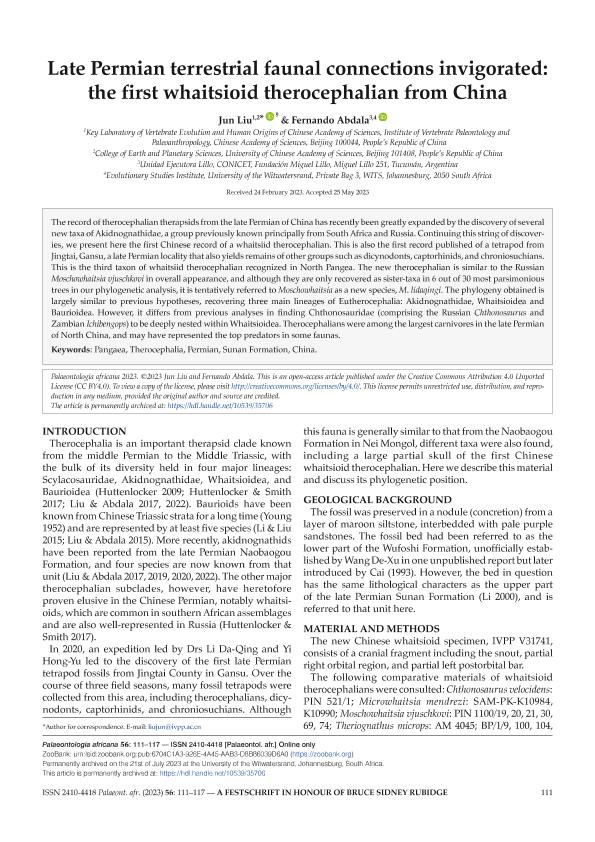Artículo
Late Permian terrestrial faunal connections invigorated: the first whaitsioid therocephalian from China
Fecha de publicación:
07/2023
Editorial:
Wits University
Revista:
Palaeontologia Africana
e-ISSN:
2410-4418
Idioma:
Inglés
Tipo de recurso:
Artículo publicado
Clasificación temática:
Resumen
The record of therocephalian therapsids from the late Permian of China has recently been greatly expanded by the discovery of severalnew taxa of Akidnognathidae, a group previously known principally from South Africa and Russia. Continuing this string of discoveries,we present here the first Chinese record of a whaitsiid therocephalian. This is also the first record published of a tetrapod fromJingtai, Gansu, a late Permian locality that also yields remains of other groups such as dicynodonts, captorhinids, and chroniosuchians.This is the third taxon of whaitsiid therocephalian recognized in North Pangea. The new therocephalian is similar to the RussianMoschowhaitsia vjuschkovi in overall appearance, and although they are only recovered as sister-taxa in 6 out of 30 most parsimonioustrees in our phylogenetic analysis, it is tentatively referred to Moschowhaitsia as a new species,M. lidaqingi. The phylogeny obtained islargely similar to previous hypotheses, recovering three main lineages of Eutherocephalia: Akidnognathidae, Whaitsioidea andBaurioidea. However, it differs from previous analyses in finding Chthonosauridae (comprising the Russian Chthonosaurus andZambian Ichibengops) to be deeply nested within Whaitsioidea. Therocephalians were among the largest carnivores in the late Permianof North China, and may have represented the top predators in some faunas.
Palabras clave:
PANGAEA
,
THEROCEPHALIA
,
PERMIAN
,
SUNAN FORMATION
Archivos asociados
Licencia
Identificadores
Colecciones
Articulos(UEL)
Articulos de UNIDAD EJECUTORA LILLO
Articulos de UNIDAD EJECUTORA LILLO
Citación
Liu, Jun; Abdala, Nestor Fernando; Late Permian terrestrial faunal connections invigorated: the first whaitsioid therocephalian from China; Wits University; Palaeontologia Africana; 56; 7-2023; 1-7
Compartir




